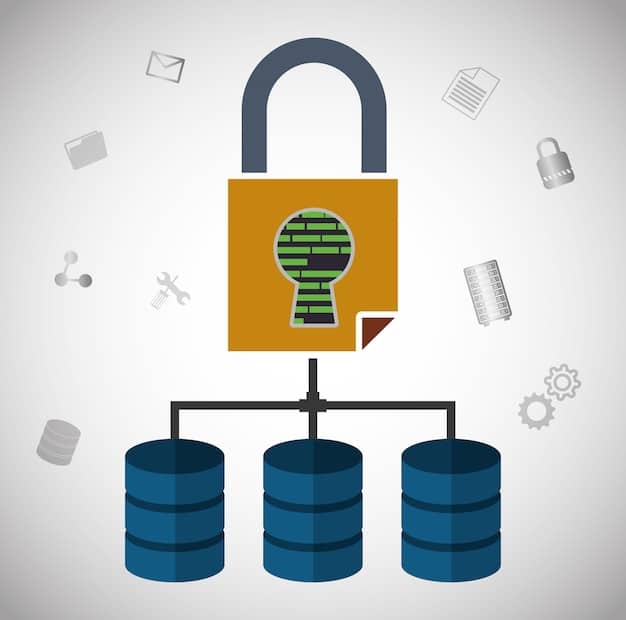US Tech Companies Face Data Privacy Scrutiny: What to Know

US tech companies face increasing scrutiny over their data privacy practices due to growing concerns about user data collection, storage, and usage, leading to potential regulations and public backlash.
The digital landscape is increasingly shaped by how tech companies handle our data. US Tech Companies Face Scrutiny Over Data Privacy Practices: What You Need to Know in this evolving environment, especially as concerns about privacy grow.
Understanding the Data Privacy Landscape in the US
Data privacy has become a central issue in the digital age, particularly in the United States, where tech giants wield considerable influence. The evolving landscape of data privacy involves regulations, consumer expectations, and the ethical responsibilities of companies that handle vast amounts of personal information.
Understanding this landscape requires a closer look at the key players, the regulations in place, and the ongoing debates surrounding data privacy.
Key Players in the Data Privacy Arena
Several entities shape the data privacy landscape in the US, including tech companies themselves, regulatory bodies, and advocacy groups. Tech companies such as Google, Facebook (Meta), Amazon, and Apple are at the forefront, as they collect and process massive amounts of user data.
Regulatory bodies like the Federal Trade Commission (FTC) and state attorneys general play a crucial role in enforcing data privacy laws and holding companies accountable. Advocacy groups such as the Electronic Frontier Foundation (EFF) and the American Civil Liberties Union (ACLU) advocate for stronger privacy protections and raise public awareness.

Current Data Privacy Regulations
In the US, data privacy regulations are a mix of federal and state laws. There is no single, comprehensive federal law governing data privacy, as is the case in Europe with the General Data Protection Regulation (GDPR). Instead, the US relies on a patchwork of sector-specific laws, such as the Health Insurance Portability and Accountability Act (HIPAA) for healthcare data and the Children’s Online Privacy Protection Act (COPPA) for children’s online data.
- California Consumer Privacy Act (CCPA): Grants consumers the right to know what personal data is collected about them, the right to delete personal data, and the right to opt-out of the sale of their personal data.
- California Privacy Rights Act (CPRA): Amends and expands upon the CCPA, establishing a new enforcement agency, the California Privacy Protection Agency (CPPA).
- Other State Laws: States like Virginia, Colorado, and Utah have also enacted comprehensive data privacy laws, each with its own nuances and requirements.
These regulations aim to give consumers more control over their personal data and increase transparency regarding data practices.
In conclusion, the data privacy landscape in the US is complex and evolving, involving numerous key players and a mix of federal and state regulations, all striving to address the growing concerns about how personal data is handled.
Common Data Privacy Concerns
Several recurring concerns dominate the discourse around data privacy, particularly regarding how tech companies collect, use, and protect user data. These concerns are not merely hypothetical; they often stem from real-world incidents and growing awareness among consumers.
Examining these issues is crucial in understanding the broader implications of data practices employed by tech companies.
Data Collection and Usage
One of the primary concerns revolves around the extent to which tech companies collect personal data. Many users are unaware of the sheer volume of information gathered about them, which can include browsing history, location data, purchase records, and even biometric data. This data is often used for targeted advertising, personalized content, and predictive analytics.
The opaqueness surrounding data usage is also a major concern. While companies often outline their data practices in privacy policies, these policies are frequently long, complex, and difficult for the average user to understand. This lack of transparency makes it challenging for individuals to make informed decisions about their privacy.
Data Security and Breaches
Data security is another critical concern, as breaches and hacks can expose sensitive personal information to malicious actors. High-profile data breaches, such as those experienced by Equifax, Target, and Yahoo, have demonstrated the potential for significant harm, including identity theft, financial loss, and reputational damage.
- Inadequate Security Measures: Companies may fail to implement adequate security measures, leaving data vulnerable to unauthorized access.
- Third-Party Risks: Many companies rely on third-party vendors for data storage and processing, introducing additional security risks.
- Insider Threats: Data breaches can also result from insider threats, where employees or contractors misuse or steal sensitive data.
Lack of Transparency and Control
Many users feel they lack control over their personal data. Although regulations like CCPA and GDPR provide some rights, such as the right to access and delete data, exercising these rights can be cumbersome. Additionally, many users are unaware of their rights or lack the technical skills to enforce them.
The lack of transparency surrounding data practices also contributes to this sense of powerlessness. Companies often use vague language in their privacy policies, making it difficult for users to understand how their data is being used. This lack of transparency erodes trust and makes it harder for individuals to make informed decisions about their privacy.

In summary, common data privacy concerns include the extent of data collection, security vulnerabilities, and the lack of transparency and user control, all of which contribute to a growing sense of unease among consumers.
Impact on Tech Companies and Users
Increased scrutiny over data privacy practices has a profound impact on both tech companies and their users. For tech companies, it means navigating new regulatory landscapes, adapting business models, and investing in stronger privacy protections. For users, it brings both greater awareness and new challenges in protecting their personal information.
Let’s examine the specific ways in which this scrutiny affects these two groups.
Challenges for Tech Companies
Tech companies face numerous challenges as they grapple with increasing data privacy scrutiny. Compliance with new regulations, such as CCPA and GDPR, requires significant investments in technology, personnel, and legal expertise. Companies must also adapt their data practices to meet the requirements of these laws, which can involve redesigning products and services.
Reputational risks are also a significant concern. Data breaches and privacy violations can damage a company’s reputation, leading to loss of customers, decreased stock value, and increased regulatory scrutiny. Maintaining user trust is therefore crucial, but it requires demonstrating a commitment to data privacy.
Benefits for Users
For users, increased data privacy scrutiny brings several potential benefits. Greater awareness of data practices can empower individuals to make more informed decisions about their online activities. Regulations like CCPA and GDPR grant users specific rights, such as the right to access, delete, and opt-out of the sale of their data.
- Enhanced Control Over Data: Users have more tools to manage their privacy settings and limit the collection of their personal data.
- Increased Transparency: Companies are becoming more transparent about their data practices, providing clearer explanations of how data is collected and used.
- Stronger Legal Protections: Regulations provide legal recourse for users who have been harmed by privacy violations.
Potential Drawbacks for Users
Despite the potential benefits, increased data privacy scrutiny also presents some drawbacks for users. The complexity of privacy regulations can be overwhelming, making it difficult for individuals to understand their rights and exercise them effectively. Additionally, some companies may respond to data privacy regulations by limiting access to services or increasing prices.
Another potential drawback is the “privacy paradox,” where individuals express concern about their privacy but continue to engage in risky online behaviors. This disconnect between attitudes and actions can undermine the effectiveness of privacy protections.
In conclusion, while increased data privacy scrutiny poses challenges for tech companies, it also brings potential benefits for users, including greater awareness, enhanced control, and stronger legal protections, although drawbacks such as complexity and potential limitations on services must also be considered.
Future Trends in Data Privacy
The landscape of data privacy is continually evolving, driven by technological advancements, changing consumer expectations, and regulatory developments. Several key trends are likely to shape the future of data privacy in the coming years.
Understanding these trends is crucial for both tech companies and individuals seeking to navigate the complex world of data privacy.
Emerging Technologies and Privacy
Emerging technologies such as artificial intelligence (AI), blockchain, and the Internet of Things (IoT) present both opportunities and challenges for data privacy. AI algorithms can process vast amounts of data to personalize services and improve decision-making, but they also raise concerns about bias, discrimination, and surveillance. Blockchain technology offers potential solutions for secure data storage and identity management, but it also introduces new complexities.
The proliferation of IoT devices, from smart home appliances to wearable fitness trackers, generates massive amounts of data, often without clear privacy protections. Addressing these challenges will require new approaches to data governance and privacy-enhancing technologies.
Evolving Regulatory Landscape
The regulatory landscape is expected to continue evolving, with more states considering and enacting comprehensive data privacy laws. There is also growing pressure for a federal data privacy law in the US, which could provide a uniform set of rules and standards for companies to follow. International cooperation on data privacy issues is also likely to increase.
- Federal Legislation: A comprehensive federal data privacy law could harmonize the regulatory landscape and provide stronger protections for consumers.
- Global Standards: International agreements and frameworks could facilitate the cross-border transfer of data while ensuring adequate privacy protections.
- Increased Enforcement: Regulatory bodies are likely to increase their enforcement efforts, holding companies accountable for privacy violations.
Shifting Consumer Expectations
Consumer expectations regarding data privacy are also changing. As awareness of data practices grows, individuals are becoming more demanding of transparency, control, and accountability. Companies that prioritize data privacy are likely to gain a competitive advantage. There is a growing demand for privacy-friendly products and services, as well as greater control over personal data.
In the future, data privacy is likely to become a key differentiator for companies, with those that prioritize privacy gaining a competitive advantage.
In summary, future trends in data privacy include the impact of emerging technologies, the evolving regulatory landscape, and shifting consumer expectations, all of which will shape how data is collected, used, and protected in the years to come.
Best Practices for Protecting Your Data
Protecting your personal data in the digital age requires a proactive and informed approach. While regulations and corporate policies play a crucial role, individuals also have a responsibility to take steps to safeguard their privacy.
Implementing these practices can significantly reduce the risk of privacy breaches and data misuse.
Review and Adjust Privacy Settings
One of the simplest and most effective steps is to review and adjust the privacy settings on your online accounts and devices. Many platforms offer granular controls over what data is collected and how it is used. Take the time to understand these settings and customize them to your preferences. Regularly review your privacy settings, as platforms often update them.
Adjust settings on social media accounts, web browsers, and mobile devices.
Use Strong Passwords and Enable Two-Factor Authentication
Strong passwords are essential for protecting your accounts from unauthorized access. Use a combination of upper- and lower-case letters, numbers, and symbols, and avoid using easily guessable information like birthdates or pet names. Enable two-factor authentication (2FA) whenever possible, as it adds an extra layer of security by requiring a second verification method, such as a code sent to your phone.
- Password Managers: Consider using a password manager to generate and store strong, unique passwords for all your accounts.
- Regularly Update Passwords: Change your passwords regularly, especially for sensitive accounts like email and banking.
- Avoid Password Reuse: Never use the same password for multiple accounts.
Be Mindful of What You Share Online
Think carefully about what you share online, as anything you post can potentially be seen by a wide audience. Avoid sharing sensitive personal information, such as your address, phone number, or financial details, unless it is absolutely necessary and you are confident in the security of the platform.
Be cautious about sharing personal information on social media and public forums.
Install Security Software and Keep It Updated
Installing antivirus software and keeping it updated is crucial for protecting your devices from malware and other threats. Security software can detect and remove malicious programs, as well as provide real-time protection against online threats. Keep your operating system and software applications updated to patch security vulnerabilities.
Ensure your antivirus software is always up-to-date.
By following these best practices, individuals can significantly enhance their data privacy and reduce the risk of privacy breaches and data misuse.
The Role of Education and Awareness
Education and awareness are vital components of a comprehensive data privacy strategy. Informed individuals are better equipped to protect their personal data, advocate for stronger privacy protections, and hold companies accountable for their data practices.
Promoting education and awareness can empower individuals and contribute to a more privacy-conscious society.
Promoting Digital Literacy
Digital literacy is the ability to use digital technology effectively and responsibly. This includes understanding how to evaluate online information, protect personal data, and navigate the digital landscape safely. Promoting digital literacy can empower individuals to make informed decisions about their online activities and protect themselves from fraud and scams.
- Educational Programs: Schools, libraries, and community organizations can offer educational programs on digital literacy and data privacy.
- Online Resources: Numerous online resources provide information and guidance on data privacy and digital security.
- Awareness Campaigns: Public awareness campaigns can raise awareness of data privacy issues and promote best practices.
Data Privacy Advocacy
Data privacy advocacy involves speaking out for stronger privacy protections and holding companies accountable for their data practices. This can include contacting lawmakers, supporting advocacy groups, and participating in public discussions. By advocating for stronger privacy protections, individuals can contribute to a more privacy-conscious society.
Support organizations that advocate for data privacy.
Corporate Responsibility
Companies also have a responsibility to educate their users about data privacy and promote best practices. This can include providing clear and accessible privacy policies, offering privacy-enhancing tools, and supporting digital literacy initiatives. By prioritizing education and awareness, companies can build trust with their users and demonstrate a commitment to data privacy.
Companies should be transparent about their data practices.
In summary, education and awareness are crucial for empowering individuals to protect their personal data, advocate for stronger privacy protections, and hold companies accountable for their data practices, ultimately contributing to a more privacy-conscious society.
| Key Point | Brief Description |
|---|---|
| 🛡️ Data Privacy Landscape | Complex US regulations and key players shaping data protection. |
| 🔒 Common Concerns | Data collection, security breaches, and lack of user control. |
| 📈 Future Trends | Emerging tech, evolving laws, and shifting user expectations. |
| 💡 Protecting Data | Adjust privacy settings, use strong passwords, and stay informed. |
Frequently Asked Questions
▼
Data privacy refers to the proper handling of personal information. It is important because it protects individuals from misuse of their data, such as identity theft, discrimination, and unwanted surveillance, ensuring their rights and control over personal information.
▼
The US has a patchwork of data privacy laws, including the California Consumer Privacy Act (CCPA), the California Privacy Rights Act (CPRA), and sector-specific laws like HIPAA for health data and COPPA for children’s online data, each addressing specific aspects of privacy.
▼
Tech companies collect user data through various means, including tracking browsing history, using cookies, monitoring location data, analyzing purchase records, and gathering information shared on social media platforms, often without explicit user consent.
▼
To protect your data privacy, review and adjust privacy settings on your accounts, use strong passwords, enable two-factor authentication, be mindful of what you share online, install security software, and stay informed about data privacy issues and best practices.
▼
Education plays a crucial role in data privacy by promoting digital literacy, raising awareness of privacy risks, and empowering individuals to make informed decisions about their data. Informed users are better equipped to protect themselves and advocate for privacy rights.
Conclusion
As US Tech Companies Face Scrutiny Over Data Privacy Practices: What You Need to Know, staying informed, taking proactive measures to protect your data, and advocating for stronger privacy protections are essential steps. By understanding the challenges and opportunities in the data privacy landscape, both individuals and companies can contribute to a more secure and trustworthy digital environment.





